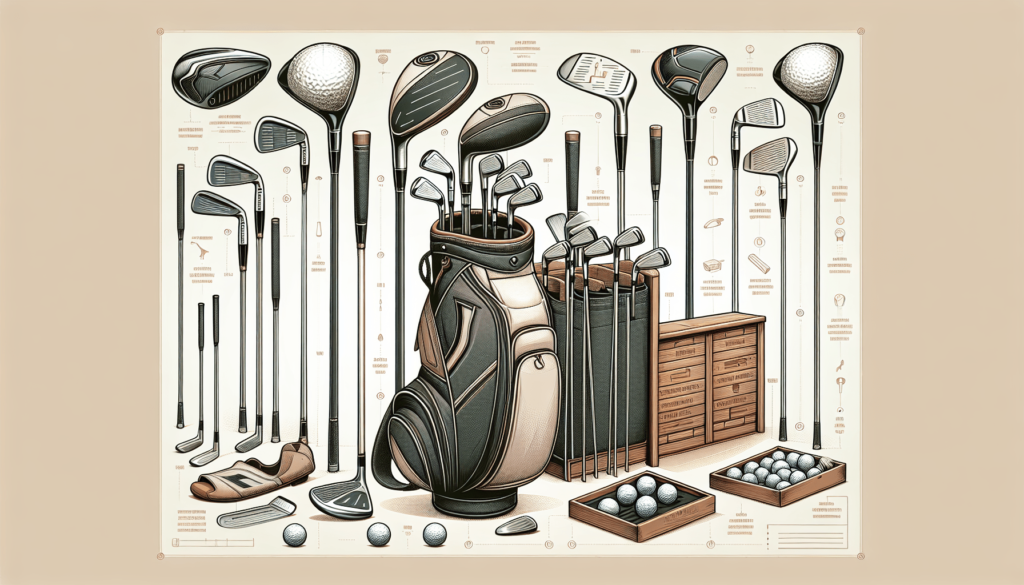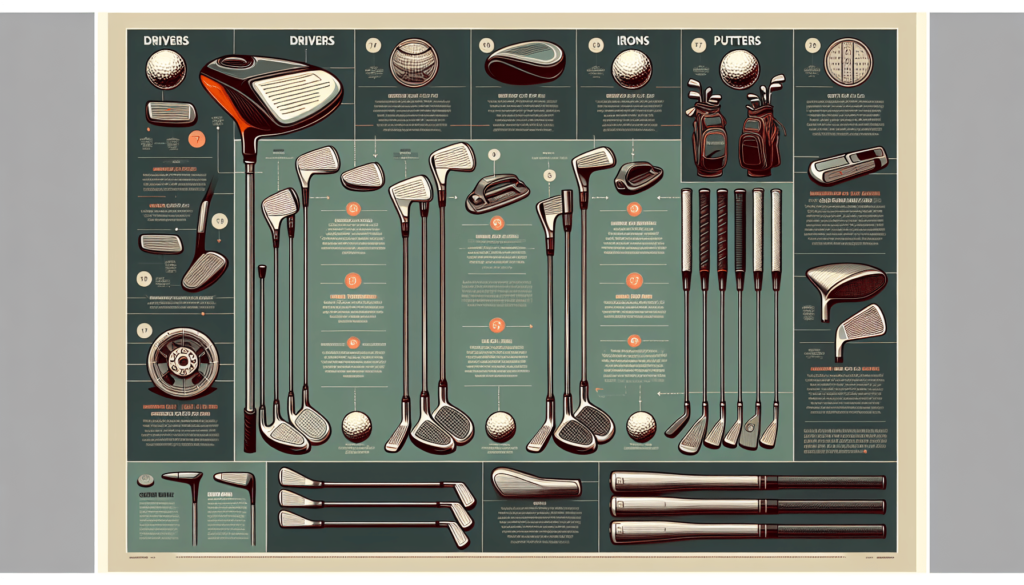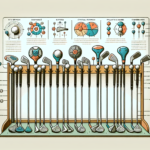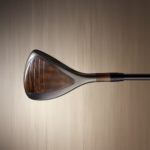
In the realm of golf, possessing the appropriate arsenal of clubs can significantly impact one’s game. Whether you are a seasoned player or a novice looking to improve, it is essential to equip yourself with the most vital golf clubs. These indispensable tools enable golfers to navigate the sprawling greens with precision and finesse, enhancing their overall performance on the course. To ensure a comprehensive golfing experience, every golfer should prioritize the acquisition of these essential clubs, which effortlessly amplify their swing power, accuracy, and overall control. Discover the key instruments that should proudly occupy every golfer’s bag, paving the way for a remarkable golfing journey.
Essential Golf Clubs for Every Golfer
As a golfer, it is important to have the right equipment in your bag to enhance your game and improve your performance on the course. In this article, we will discuss the essential golf clubs that every golfer should have in their bag. From the driver to the putter, we will explore the key features and factors to consider when selecting each club. So, let’s dive in and learn more about these essential golf clubs!

1. Driver
Size and Material
The driver is typically the longest club in a golfer’s bag and is used for tee shots on longer holes. When choosing a driver, size and material play a significant role. The driver’s head is usually made from materials such as titanium or composite, which provide strength and maximum forgiveness. Look for a driver with a larger clubhead size to ensure a larger sweet spot, increasing the likelihood of straighter and longer drives.
Adjustability
Another important factor to consider when selecting a driver is adjustability. Many modern drivers offer adjustable features such as loft, lie angle, and weight distribution. These adjustable settings allow you to fine-tune your driver to match your swing and optimize your performance on the course. Having an adjustable driver gives you the versatility to adapt to different course conditions and tailor your shots accordingly.
Shaft Flex
The shaft flex of a driver plays a crucial role in determining the trajectory and accuracy of your shots. Golfers with a slower swing speed typically benefit from a more flexible shaft (regular or senior flex), while golfers with a higher swing speed may require a stiffer shaft (stiff or extra-stiff flex) for optimal control and power. It is essential to select a driver with the appropriate shaft flex that complements your swing style and generates maximum distance off the tee.
2. Fairway Woods
Loft Angle
Fairway woods, also known as metal woods, are versatile clubs used for long shots from the fairway or off the tee on shorter holes. The loft angle of a fairway wood is an important consideration when choosing the right club for your bag. Lower lofted fairway woods, such as 3-woods or 4-woods, are ideal for generating distance and hitting off the tee, while higher lofted fairway woods, like 5-woods or 7-woods, provide more loft and are suitable for approach shots into greens or shots from the rough.
Shaft Length
The shaft length of a fairway wood can significantly influence your swing mechanics and shot control. Longer shafts tend to generate more clubhead speed, resulting in increased distance but potentially sacrificing accuracy. Conversely, shorter shafts offer improved control but may sacrifice some distance. It is important to find a fairway wood with a shaft length that matches your swing style and allows you to strike the ball consistently and accurately.
Clubhead Size
Similar to drivers, fairway woods come in various clubhead sizes. Larger clubhead sizes typically provide a larger sweet spot, enhancing forgiveness and making it easier to get the ball airborne. However, larger clubheads may sacrifice a bit of control. On the other hand, smaller clubhead sizes offer enhanced shot-shaping capabilities and control. Selecting the right clubhead size is a matter of personal preference and depends on your level of skill and playing style.
3. Hybrids
Versatility
Hybrids, often referred to as rescue clubs, are designed to replace traditional long irons, providing golfers with enhanced playability from a variety of lies. The versatility of hybrids allows golfers to navigate challenging situations on the course, such as hitting from the rough or challenging lies. The clubhead design and sole make hybrids easier to hit and launch the ball higher, making them an essential club for every golfer’s bag.
Ease of Use
One of the main advantages of hybrids is their ease of use. They are much more forgiving than long irons and provide a higher launch angle, promoting longer and straighter shots. Hybrids have a lower center of gravity, making it easier to get the ball airborne, even from tight lies or difficult circumstances. Their design and construction make them suitable for players of all skill levels, offering increased confidence and consistency in their gameplay.
Distance Control
Hybrids are incredibly useful for distance control, offering a perfect blend of distance and accuracy. They are especially beneficial for shots that require precision and control, such as approaches into greens or shots demanding a specific yardage. The design and weight distribution of hybrids allow for controlled shot shaping and consistency, giving golfers the ability to dial in their distances with ease. Adding hybrids to your bag will undoubtedly improve your scoring opportunities on the golf course.
4. Irons
Design and Construction
Irons are the backbone of a golfer’s game, providing accuracy and control for shots from the fairway and around the greens. When selecting irons, consider their design and construction. Modern irons are typically categorized into three types: cavity-back irons, blade irons, and game-improvement irons. Cavity-back irons offer forgiveness and a larger sweet spot, ideal for mid-to-high handicap golfers. Blade irons provide enhanced shot-shaping capabilities and feel but require advanced skill. Game-improvement irons combine forgiveness and playability, catering to a wide range of golfers.
Clubhead Size
Irons come in different clubhead sizes, ranging from compact blades to larger game-improvement irons. The size of the clubhead influences the forgiveness and playability of the irons. Bigger clubheads offer more forgiveness due to the increased sweet spot, allowing for better results on mishits. Smaller clubheads, such as blades, require a higher level of precision but provide more shot control for skilled players. Choose irons with a clubhead size that suits your skill level and ability to strike the ball consistently.
Shaft Composition
The composition of the shaft also plays a significant role in the performance of your irons. Shafts can vary in materials such as steel or graphite, each offering unique characteristics. Steel shafts are generally heavier and provide better control, making them suitable for players with a faster swing speed. Graphite shafts are lighter, promoting increased swing speed and distance, making them ideal for players with slower swing speeds or those seeking to maximize their distance. Selecting the right shaft composition can significantly impact your iron play, so choose wisely.

5. Wedges
Types of Wedges
Wedges are essential scoring clubs and are primarily used for shots near and around the green. There are three main types of wedges: pitching wedge (PW), gap wedge (GW), and sand wedge (SW). Pitching wedges have the least amount of loft and are typically used for full shots into greens. Gap wedges fill the loft gap between pitching wedges and sand wedges, offering versatility for a variety of shots. Sand wedges have the highest loft and are designed to help players escape greenside bunkers and make shots from the sand.
Loft Angles
Loft angles are a crucial factor to consider when selecting wedges. They determine the trajectory and distance the ball will travel. Pitching wedges typically have a loft angle between 44 and 48 degrees, gap wedges between 50 and 54 degrees, and sand wedges between 54 and 58 degrees. The loft angles should be chosen based on the distance control required and the playing conditions, ensuring you have the right tools to handle all types of shots around the green.
Bounce
Bounce is another important feature of wedges that helps prevent the clubhead from digging into the ground at impact. Higher bounce wedges are ideal for soft turf conditions or players with a steeper swing. Conversely, lower bounce wedges suit firmer turf conditions or players with a shallower swing. The bounce angle can significantly impact how the wedge interacts with the ground, ensuring clean contact and consistency in your short game. Consider the playing conditions and your swing characteristics when selecting wedges with the appropriate bounce.
6. Putter
Design and Style
The putter is arguably the most essential club in a golfer’s bag. Choosing the right putter that suits your stroke and style is crucial. Putters come in various designs and styles, including blade putters, mallet putters, and center-shafted putters. Blade putters offer a traditional look and provide more feedback, making them popular among golf purists. Mallet putters are more forgiving and offer advanced alignment aids, suitable for golfers needing extra assistance with alignment. Center-shafted putters provide stability and balance, making them a favored choice for players who prefer a straight-back, straight-through stroke.
Alignment Aid
Alignment aids on putters can significantly assist in improving your putting accuracy. Many modern putters feature alignment lines or dots on the clubhead, helping you align the putter squarely to your target line. Alignment aids provide reassurance and can enhance your confidence in your ability to putt accurately. When selecting a putter, take note of the alignment aids available and choose the one that best suits your preferences and visual alignment needs.
Length and Grip
The length and grip of your putter play crucial roles in your putting stroke mechanics. The length of the putter should allow you to maintain a comfortable and natural posture without excessive tension in your arms or back. Experiment with different putter lengths to find the one that provides optimal alignment and stroke consistency. Additionally, choosing the right grip is essential for maintaining a relaxed yet controlled grip pressure. Various grip materials and sizes are available, so try out different options to determine the one that enables a smooth and confident stroke.
7. Golf Balls
Compression
The compression of a golf ball refers to how tightly the ball is wound. Golf balls come in a range of compressions, from low to high. The compression of a ball can impact the feel and performance. Low compression balls have a softer feel and are more forgiving, making them suitable for golfers with slower swing speeds and those seeking more distance. High compression balls offer more control and are better suited for players with faster swing speeds and those prioritizing shot accuracy and control.
Spin Rate
Spin rate refers to the backspin or sidespin generated when the ball is struck. Higher spin rate balls provide more control and stopping power on the green, allowing you to hold the ball on approach shots. Lower spin rate balls tend to produce a flatter trajectory, ideal for players looking for maximum distance off the tee. Determining the ideal spin rate for your game depends on your skill level and the desired shot shape and control.
Cover Material
The cover material of a golf ball can significantly impact its performance and durability. Golf balls have either Surlyn or urethane covers. Surlyn covers offer durability and a lower price point, making them suitable for beginners or players who tend to lose a lot of balls. Urethane covers provide enhanced feel, spin control, and durability, making them a popular choice among skilled golfers. Consider your playing style, skill level, and budget when selecting golf balls with the appropriate cover material.
8. Golf Bag
Size and Weight
A golf bag is an essential accessory for carrying and organizing your clubs and other equipment on the course. When choosing a golf bag, consider its size and weight. Golf bags come in various sizes, ranging from Sunday bags for minimalistic golfers to cart bags for those who primarily use golf carts. The weight of the bag is important, as it should allow for easy carrying without causing excessive strain or fatigue. Finding a golf bag that strikes the right balance between size and weight will ensure it meets your needs and provides optimal convenience on the course.
Number of Dividers
Dividers in a golf bag help keep the clubs organized and protected during transportation. Golf bags typically come with various divider options, such as 14 full-length dividers or individual dividers. Full-length dividers offer the most protection and prevent club heads from banging against each other, minimizing the risk of damage. Individual dividers are suitable for golfers who prefer a minimalist and lightweight bag. Consider the number of clubs you typically carry and your preference for organization when selecting a golf bag with the appropriate dividers.
Storage Pockets
Storage pockets in a golf bag provide space for accessories such as balls, gloves, tees, and personal items. The number and size of storage pockets vary among golf bags. More pockets allow for better organization and easy access to necessary items during your round. Consider the types of items you typically carry on the course and ensure the bag has enough storage pockets to accommodate your needs. Additionally, check for features like insulated pockets for beverages or valuables pockets with secure zippers for added convenience and peace of mind.
9. Golf Glove
Material
A golf glove is a crucial piece of equipment that provides grip, comfort, and protection during your swing. Golf gloves are typically made from leather or synthetic materials. Leather gloves offer a better feel and grip, conforming to the shape of your hand over time. Synthetic gloves, on the other hand, provide durability, breathability, and a lower price point. Consider your preference for feel, comfort, and longevity when choosing a golf glove material that suits your needs.
Fit and Comfort
The fit and comfort of a golf glove are paramount for a proper grip and swing mechanics. A glove that fits too tightly can restrict hand movement and cause discomfort, while a loose-fitting glove may affect grip stability. Look for a golf glove that conforms to the shape of your hand, allowing for a snug yet comfortable fit. Ensure the glove provides enough flexibility and breathability to keep your hand cool and dry during your round.
Grip Support
Golf gloves can enhance grip support by providing added traction and stability during your swing. Many golf gloves feature textured or tacky materials on the palm and fingers to improve grip on the club. This is particularly beneficial in wet or humid conditions, where maintaining a secure grip can be challenging. Look for gloves that offer grip support features, such as reinforced areas or silicone grips, to enhance your connection with the club and improve control in all weather conditions.
10. Golf Shoes
Comfort and Support
Golf shoes are essential for stability and traction during your swing and while walking the course. When selecting golf shoes, prioritize comfort and support. Look for shoes with cushioned insoles and ample padding to provide all-day comfort. Proper arch support and a secure fit will help prevent fatigue and ensure stability throughout your round. Additionally, consider the overall weight of the shoes, as lighter options can enhance comfort and help reduce fatigue.
Water Resistance
Playing golf in damp or wet conditions can be challenging, especially without proper footwear. Water-resistant golf shoes help keep your feet dry and comfortable, allowing you to focus on your game. Look for shoes with waterproof materials and features such as sealed seams or waterproof liners to ensure maximum water resistance. Having water-resistant golf shoes will give you the confidence to play in various weather conditions without worrying about wet and uncomfortable feet.
Traction
Traction is a critical consideration when choosing golf shoes, as it directly affects your stability and balance during the swing. Look for shoes with strategically designed and durable rubber outsoles that provide excellent traction on various terrains, including grass, sand, and wet surfaces. Cleats or spikes on the outsole can further enhance traction in challenging conditions. Having proper traction ensures a secure base for your swing and helps prevent slips or slides, allowing for a more powerful and consistent swing.
In conclusion, having the right golf clubs and equipment in your bag is essential to improving your game and maximizing your performance on the course. From the driver to the putter, each club plays a unique role in your overall gameplay. When selecting your golf clubs, consider factors such as size, adjustability, shaft flex, loft angles, and clubhead size to ensure they match your swing style and playing ability. Additionally, other accessories like golf balls, gloves, shoes, and bags contribute to your overall comfort, convenience, and performance. By investing in quality equipment that suits your needs and preferences, you can elevate your game and enjoy a more rewarding golfing experience.





